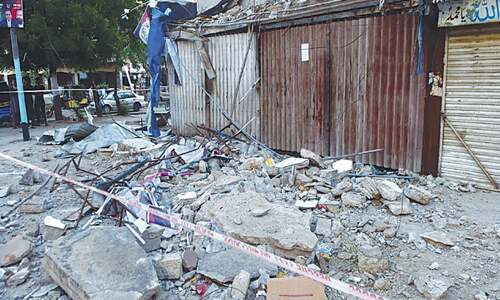Imagine a young, middle-aged or old Englishman serving in the British army or some fancy British company in pre-independence India! Imagine his name being juxtaposed with someone who is a film icon of post-independence Pakistan! Imagine names having as different auditory effects as Wilson, Gidwani and Waheed Murad, or for that matter Marshall, existing side by side in unhindered harmony. This can happen in many places of the world, but in Karachi the experience has a different, carefree ring to it. Karachi embraces change with open arms and snuggles up to its past like a child needing protection.
In case you are wondering that while Waheed Murad was a famous Pakistani film actor, who Wilson and Marshall are, well, keep wondering, for that’s one of the intriguing things about old Karachi. It, to date, has streets and roads named after British officials of colonial times about whom either very little or not at all is known. Interestingly, Wilson, Marshall and Gidwani streets don’t cover a long stretch of land and lie smack next or parallel to each other. Waheed Murad Road is one from which the three above-mentioned streets branch out into residential areas. As to where exactly these three are located, they are right behind the Mama Parsi Girls High School on M.A. Jinnah Road (formerly Bunder Road).
The road at the rear end of the famous educational institution is, believe it or not, called Waheed Murad Road. It is not difficult to find out whether it’s named after the famous film actor who passed away in 1983 and was one of Pakistan’s mega movie stars or his namesake who achieved great feat in some other discipline in life but was not as well known as the actor. No worries. A shopkeeper will tell you it’s the same ‘chocolate hero’ of the Pakistan film industry. He was a Karachiite and did his schooling from the Karachi Grammar School and obtained a master’s degree in English literature from Karachi University in the ‘50s. (The original name of Waheed Murad Road was Marston Road.) The renaming came when Waheed Murad died because in those days this zone had a decent number of cinema houses, and film distributors wanted to pay their homage to the actor who starred in all-time classics like Armaan and Doraha. Yes, it’s the area where Jubilee Cinema and some other movie screening halls were situated along with a building that housed offices of many film distributors.
Waheed Murad Road splits into at least three streets which remind you of colonial times in terms of architecture as well as their monikers. One of them is Marshall Street. The most prominent element of this gali is a large structure on top of which you can easily read Coronation House 1938. Regardless of the various shops on its ground floor — a restaurant, a milk shop and a general store — the upper stories clearly give away its vintage quality. The balconies are of different shapes and sizes, which may have undergone alteration not too long ago. There are different entrances to the four or five sets of flats, and on the entrance of one such opening Manohar Niwas 1937 is written. This creates a confusing situation, for if the whole building is called Coronation House built in 1938, then how come one of its portions has a one-year prior date? Let’s be certain on the fact that it was constructed in the 1930s.
Parallel to Marshall Street is Wilson Street. It almost has the same profile and its standout element is Razia Mansion, which is also big in size and has more or less similar architectural features as some other oldies in this area. Locals believe it has always been Razia Mansion. You can’t argue with them.
Next up is Gidwani Street and the building that corresponds to Coronation House and Razia Mansion is called Bhagwali Nawas Building. Bhagwali Nawas on the whole is pretty much like the other two structures. Its balconies, however, have certain uniformity to them — they’re not as varied in sizes and those of Coronation House and Razia Mansion, although they’re a tad smaller.
Architect Arif Hasan says: “The structures in this area are a mix of old Karachi architecture. In the 1930s and ‘40s reinforced concrete was also employed which was a result of the modernism influenced by the J.J. School of Arts in Bombay. The development of Marston Road from a residential to commercial neighbourhood happened in the 1920s. Before that it had old houses and the entire locality was lined with imli trees. In 1905 or 1906 the city was hit by a devastating cyclone which destroyed most of the trees. After partition three cinemas were built opposite Jubilee Cinema, which was why it became known for showbiz related activities.”
They say Waheed Murad died at a young age, that is, when he was in his forties. Wrong. He’s not dead. He’s still alive in the hearts of the teeming millions who have seen and admired his remarkable role-playing in films. His memory has a conspicuous, undeniable presence, just like the presence of the stone-made buildings on Marshall, Wilson and Gidwani streets.
mohammad.salman@dawn.com














































Dear visitor, the comments section is undergoing an overhaul and will return soon.